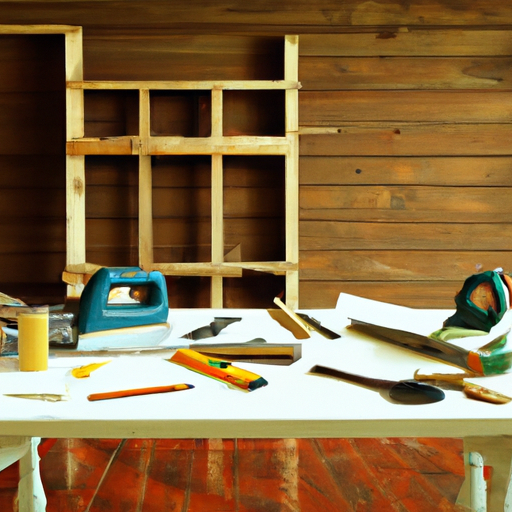Imagine stepping into your very own home woodworking shop, a space carefully designed to maximize efficiency and productivity. Picture a layout that seamlessly integrates all your tools and workstations, allowing you to effortlessly move from one task to another. In this article, we will explore the key elements and considerations to keep in mind when creating a functional layout for your home woodworking shop. Whether you’re a seasoned craftsman or a beginner looking to set up your first workshop, this guide will provide you with valuable insights and practical tips to optimize your woodworking experience. Get ready to transform your space into a haven for creativity and craftsmanship!
Planning Your Space
When planning your home woodworking shop, the first step is assessing the available area. Take a good look at the space you have and consider its dimensions and layout. This will help you determine how to best utilize the area and make the most of the available space.
Next, you need to consider workflow and traffic flow. Think about how you will move around the shop and how different woodworking tasks will be carried out. It’s important to have a clear and logical flow in your workspace to avoid any unnecessary obstacles and maximize efficiency.
Determining the size and shape of workstations is another crucial aspect of planning your space. Think about the types of projects you will be working on and the equipment you will be using. This will help you determine the size and layout of each workstation to ensure that you have enough space to comfortably work on your projects.
Organizing Workstations
To create an efficient woodworking shop, it’s important to designate specific areas for different woodworking tasks. This will help you stay organized and ensure that you have everything you need within easy reach. Consider setting up separate areas for cutting, sanding, assembly, and finishing, for example.
Arranging workstations based on workflow is another important consideration. Think about the order in which you typically complete tasks and make sure that your workstations are set up in a logical sequence. This will help streamline your workflow and make your woodworking projects run smoothly.
Ensuring sufficient lighting and ventilation for each workstation is essential. Good lighting is crucial for accuracy and safety, so make sure that each workstation is well-lit. Additionally, proper ventilation is important to minimize the buildup of dust and harmful fumes. Consider installing ventilation systems or fans to keep the air in your shop clean and safe.

Storage Solutions
Determining the types of materials and tools to be stored is the first step in finding suitable storage solutions. Take an inventory of your woodworking tools and materials and determine how much storage space you will need. This will help you decide on the type and size of storage systems that will work best for your shop.
Choosing appropriate storage systems is key to keeping your workspace organized. Consider utilizing a combination of shelves, cabinets, and drawers to store your tools and materials. Adjustable shelving or modular storage systems can be particularly useful as they can be easily adapted to accommodate changing storage needs.
Utilizing vertical space for storage is a great way to maximize the use of your shop’s area. Consider installing cabinets or shelving units that go all the way up to the ceiling. This will help you make the most of your available space and keep everything organized and easily accessible.
Tool Placement
Arranging tools based on frequency of use will make your workflow much smoother. Keep the tools you use most frequently within easy reach, while less frequently used tools can be stored in a more accessible but less prominent location. This will save you time and effort when working on your projects.
Providing adequate workspace around each tool is important for safety and efficiency. Make sure that you have enough space to maneuver and operate each tool comfortably. This will help prevent accidents and allow you to work with ease.
Considering safety measures when placing tools is crucial. Keep tools with sharp blades or potentially dangerous components away from walkways or areas where they could pose a risk. Always ensure that tools are properly stored and secured when not in use.

Ergonomics and Accessibility
Designing work areas to minimize strain and fatigue is essential for a comfortable and safe woodworking shop. Consider the height of work surfaces and make sure they are appropriate for your height and the tasks you will be performing. Proper ergonomics will help prevent injuries and make your woodworking experience more enjoyable.
Ensuring accessibility for users with physical limitations is important for creating an inclusive woodworking shop. Consider incorporating adjustable work surfaces and seating options to accommodate different needs. This will help make your shop accessible to everyone, regardless of their physical abilities.
Providing adjustable work surfaces and seating is also beneficial for creating a comfortable and ergonomic workspace. Being able to adjust the height of your work surfaces and seating will allow you to work in a position that is most comfortable for you, thus minimizing strain on your body.
Electrical and Dust Collection Systems
Determining the power requirements for tools and equipment is crucial for planning your electrical system. Make a list of all the tools and equipment you will be using and determine their power needs. This will help you determine the number and type of outlets and circuits required to power your woodworking shop.
Installing sufficient outlets and circuits is important to ensure that you have enough power for your tools and equipment. Consider consulting with an electrician to help you design and install a safe and efficient electrical system for your woodworking shop.
Incorporating a dust collection system is essential for maintaining a clean and safe woodworking environment. Woodworking produces a lot of dust, which can be harmful to your health if ingested or inhaled. A dust collection system will help capture and remove dust particles from the air, keeping your shop clean and reducing potential health risks.

Flooring and Surface Materials
Choosing appropriate flooring materials for your woodworking shop is important for both safety and functionality. Look for flooring options that are durable, easy to clean, and resistant to stains and spills. Consider options like epoxy, rubber, or vinyl flooring, which are all popular choices for woodworking shops.
Considering the durability and ease of maintenance is also important when selecting workbench and table surfaces. Look for materials that are resistant to cuts, scratches, and stains, so you can work on your projects without worrying about damaging the surfaces. Options like solid hardwood, plywood, or laminate are all great choices for workbench and table surfaces.
Selecting suitable workbench and table surfaces is essential for creating a functional woodworking shop. Make sure you have enough space to comfortably work on your projects and that the surfaces are sturdy enough to support the weight of your tools and materials.
Safety Measures
Providing adequate lighting and visibility is important for creating a safe woodworking shop. Good lighting will help you see your work clearly, reducing the risk of accidents. Consider installing bright, energy-efficient lighting fixtures and make sure that all areas of your shop are well-lit.
Installing effective fire prevention and suppression systems is crucial for the safety of your woodworking shop. Make sure you have fire extinguishers readily available and consider installing smoke detectors and sprinkler systems. It’s better to be prepared and have measures in place to prevent and extinguish fires than to risk a potentially devastating accident.
Ensuring proper ventilation is crucial to minimize harmful fumes in your woodworking shop. Woodworking processes can release harmful chemicals and fumes, so it’s important to have a ventilation system in place to remove these pollutants from the air. Consider installing fans or a ventilation system to help maintain clean and safe air quality in your shop.

Workshop Layout Techniques
Grouping similar tools and equipment together is a simple yet effective way to organize your woodworking shop. By having all your cutting tools in one area, sanding tools in another, and so on, you can easily find what you need and streamline your workflow. Consider setting up designated zones for different woodworking processes to keep everything organized.
Creating zones for different woodworking processes can help increase efficiency in your shop. For example, you could have a cutting zone with your saws and cutting tools, a sanding zone with sanders and other sanding equipment, and an assembly zone with your workbenches and tools for joining pieces together. This way, you can easily move from one task to another without wasting time searching for tools and equipment.
Taking advantage of wall space for tool storage is a great way to make the most of your available space. Install pegboards, racks, or shelves on your walls to hang and store your tools. This will keep them easily accessible and prevent clutter on your work surfaces.
Future Expandability
Designing a flexible layout is important if you anticipate expanding your woodworking shop in the future. Leave room for additional tools and equipment so that you can easily incorporate them into your workspace when needed. It’s much easier to plan for expansion in the beginning rather than having to reconfigure your entire layout later on.
Leaving room for additional tools and equipment is also important for keeping your shop organized. As you acquire more tools and materials, you’ll need sufficient space to store them. By planning for future expansion, you can ensure that you have enough storage space to keep everything organized and easily accessible.
Allowing for easy reconfiguration of workstations is another benefit of planning for future expandability. As your woodworking projects and needs change, you may want to rearrange your workstations. By designing a flexible layout, you can easily reconfigure your workspace to accommodate new projects or workflows.


